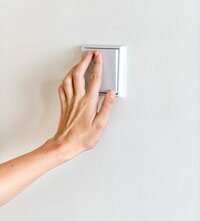Want to create more atmosphere at home or adjust the brightness of your lighting? Replacing a standard light switch with a dimmer is a smart solution. A dimmer allows you to adjust the light level to your preference, which is not only more comfortable but can also help reduce energy consumption. In this article, we explain step by step how to replace a switch with a dimmer, what to watch out for, and how to choose the right type.
Dimmers are ideal in rooms where you don’t always need full brightness, such as living rooms, bedrooms, or dining areas. With a simple turn or press, you can set the mood for any occasion—whether it’s a movie night or reading a book.
Dimming can also extend the lifespan of your bulbs and save energy, especially with traditional incandescent and halogen lamps. However, make sure your lamps are dimmable before making the switch.
Not every dimmer works with every bulb type. Choosing the right dimmer is essential:
If you use the wrong type of dimmer, your lights may flicker, buzz, or even get damaged. Always check the bulb and dimmer specs for compatibility.
Go to your electrical panel and switch off the circuit breaker for the relevant lighting group. Use a voltage tester to confirm the wires are no longer live.
Remove the faceplate and unscrew the switch from the wall box. Take a picture of the wiring or make a note of the connections before disconnecting anything.
Connect the wires to the appropriate terminals on the dimmer. Usually, this means connecting the live wire to "L" and the output to the terminal marked with an arrow or "load". Some dimmers may also require a neutral wire.
Secure the dimmer in the wall box and reattach the faceplate. Turn the power back on and test whether the light turns on and dims smoothly.
With the right dimmer and compatible lighting, you can enjoy flexible and atmospheric lighting for years to come. Whether you opt for a classic rotary dimmer or a modern smart dimmer, replacing a switch takes only a few minutes and delivers big benefits in comfort and control.
No comments found.
